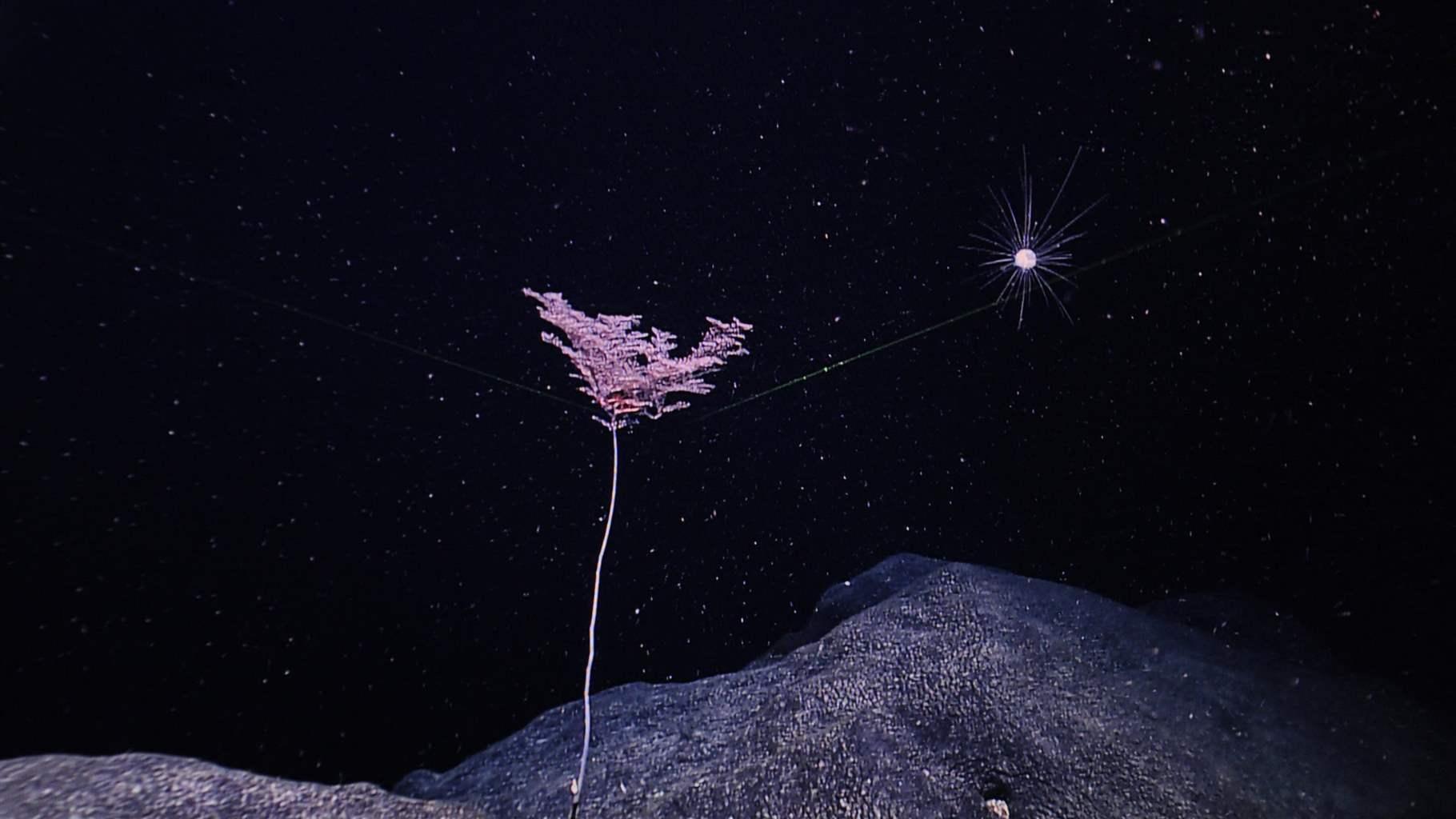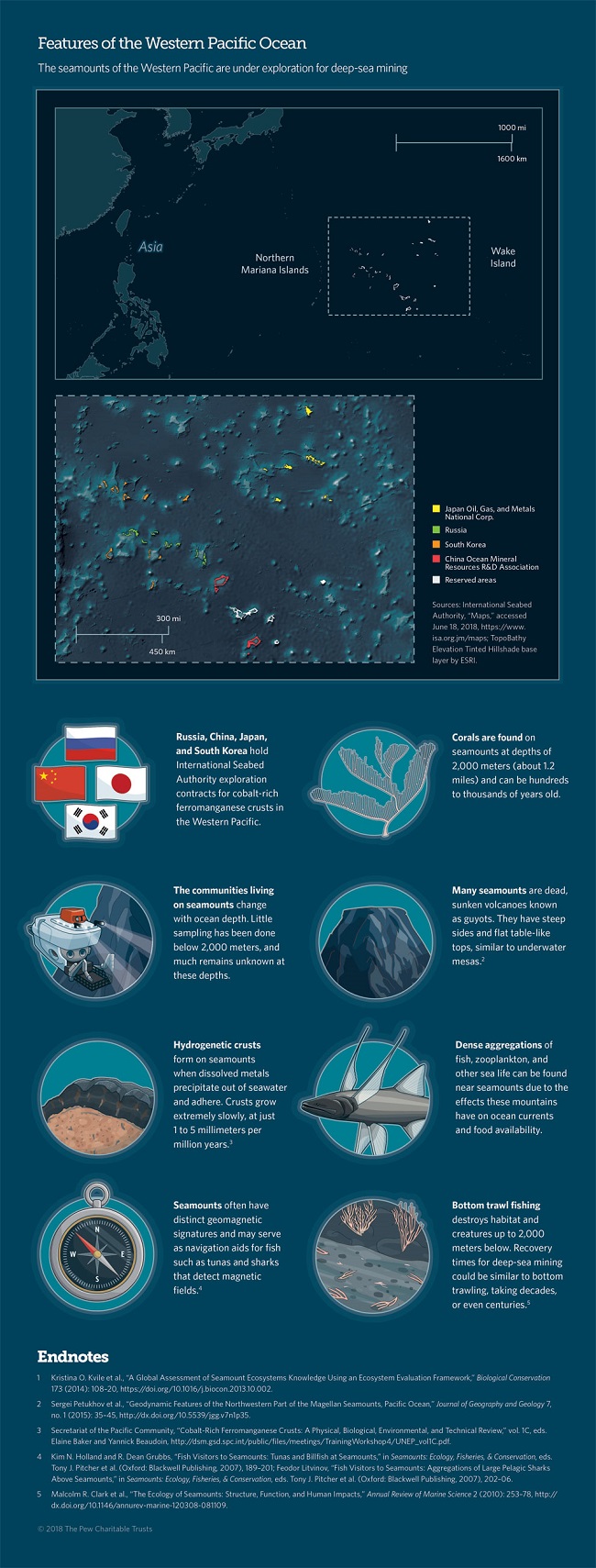The Western Pacific Ocean
Underwater seamounts need to be studied as mining interest grows
Overview
Seamounts are large underwater mountains found throughout the world’s oceans. Home to deep-sea corals, mollusks, crustaceans, and large schools of fish, they are often classified as biodiversity hot spots. And yet these vital ecosystems remain poorly studied. By one estimate, less than 4 percent of the world’s seamounts have been directly sampled.1 In the Western Pacific Ocean, the mineral-rich crusts of these mountains are attracting the interest of potential deep-sea miners.
Cobalt, nickel, copper, platinum, and rare earth elements are found within the outermost crusts covering the flanks and summits of seamounts in the Western Pacific. Mining seamounts would involve removing the cobaltrich outer layer—eliminating or degrading habitats and causing significant ecosystem impacts in the process. Sediment plumes could smother life forms even beyond the mining zones.
Given their significance as habitat and biodiversity hot spots, seamounts may require protections to minimize damage from mining. Because so much remains unknown about seamounts and nearby habitats, a precautionary approach is needed when it comes to exploration and potential mineral extraction.
The International Seabed Authority (ISA) is responsible for managing the mineral resources of the high seas “for the benefit of mankind.” Under the U.N. Convention on the Law of the Sea, the ISA is tasked with both managing seabed mining and protecting the marine environment from harmful effects of that mining. The authority is drafting rules that will attempt to honor both imperatives. The Pew Charitable Trusts and other international conservation organizations are calling for an environmentally precautionary code, one feature of which would be the establishment of large ecologically important no-mining zones in areas such as the Western Pacific.
Endnotes
- Kristina O. Kvile et al., “A Global Assessment of Seamount Ecosystems Knowledge Using an Ecosystem Evaluation Framework,” Biological Conservation 173 (2014): 108–20, https://doi.org/10.1016/j.biocon.2013.10.002.
- Sergei Petukhov et al., “Geodynamic Features of the Northwestern Part of the Magellan Seamounts, Pacific Ocean,” Journal of Geography and Geology 7, no. 1 (2015): 35–45, http://dx.doi.org/10.5539/jgg.v7n1p35.
- Secretariat of the Pacific Community, “Cobalt-Rich Ferromanganese Crusts: A Physical, Biological, Environmental, and Technical Review,” vol. 1C, eds. Elaine Baker and Yannick Beaudoin, http://dsm.gsd.spc.int/public/files/meetings/TrainingWorkshop4/UNEP_vol1C.pdf.
- Kim N. Holland and R. Dean Grubbs, “Fish Visitors to Seamounts: Tunas and Billfish at Seamounts,” in Seamounts: Ecology, Fisheries, & Conservation, eds. Tony J. Pitcher et al. (Oxford: Blackwell Publishing, 2007), 189–201; Feodor Litvinov, “Fish Visitors to Seamounts: Aggregations of Large Pelagic Sharks Above Seamounts,” in Seamounts: Ecology, Fisheries, & Conservation, eds. Tony J. Pitcher et al. (Oxford: Blackwell Publishing, 2007), 202–06.
- Malcolm R. Clark et al., “The Ecology of Seamounts: Structure, Function, and Human Impacts,” Annual Review of Marine Science 2 (2010): 253–78, http://dx.doi.org/10.1146/annurev-marine-120308-081109.













